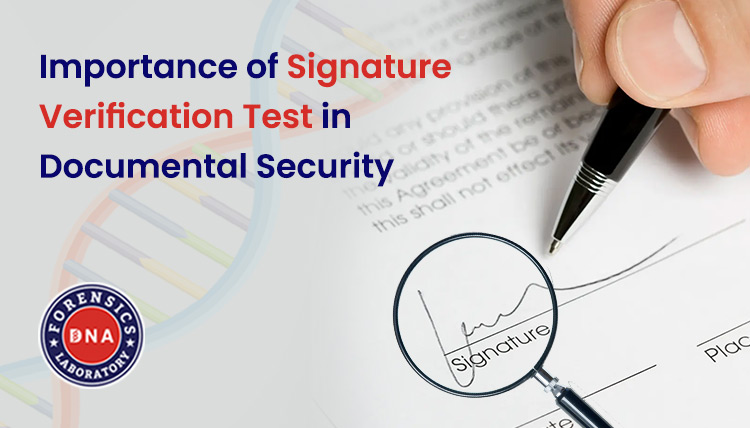Signatures are more than just scribbles on a piece of paper; they are powerful symbols of identity, consent, and commitment. They have been used throughout history to signify agreement, authorization, and validation. However, the age-old practice of signing documents and agreements has its vulnerabilities. This is where signature verification comes into play. This test helps determine whether a signature is genuine or forged. This blog will explore the dark side of forgery and shed light on the importance of Signature Verification forensics tests.
How Does the Signature Verification Test Determine the Variations?
When it comes to verifying signatures, it’s crucial to meticulously inspect the documents for any inconsistencies or signs of forgery. These tests are essential to prevent white-collar crimes such as forgery under IPC section 465, where documents are fabricated or altered with fraudulent intent. Key indicators of forged signatures are identified through careful analysis in signature verification tests:
- Slow & Methodical Strokes – Forgers often exhibit a slow and deliberate approach when replicating a signature. This contrasts with genuine signatures that usually have a more fluid and natural stroke pattern.
- No Variation in Pen Pressure – A genuine signature displays variations in pen pressure due to natural writing tendencies. In contrast, forgeries may lack these variations, showing consistent pressure throughout the signature.
- Unnatural Tremor – Some forgers struggle to mimic the natural tremor present in genuine signatures. This lack of tremor can be a red flag indicating potential forgery.
- Patching – Forgers might attempt to replicate specific signature segments separately and then combine them. This can result in a signature with noticeable inconsistencies or “patching.”
Methods of Signature Verification Forensic Test
Recent advancements in technology have brought about innovative methods for signature verification, enhancing the accuracy & reliability of this crucial authentication process. Here are some of the latest methods and technologies used for signature verification:
- UV Scan (Ultraviolet Scanning) – UV scanning is a modern technique that uses ultraviolet light to examine signatures. Ultraviolet light reveals features that may not be visible under normal lighting conditions. In the context of signature verification, UV scanning can unveil hidden security elements or alterations in the ink that may not be apparent to the naked eye. This method is beneficial in detecting forgeries and counterfeit signatures.
- Spectrophotometers – Spectrophotometers are sophisticated devices that measure light intensity at different wavelengths. In signature verification, spectrophotometers can analyze the ink used in a signature. By assessing the spectral characteristics of the ink, it becomes possible to determine if different inks were used, which may indicate forgery or alterations. Spectrophotometers offer a highly precise and quantitative approach to signature analysis.
- Spectro Lens with Color Filters – Spectro lenses with color filters are specialized tools for examining signatures. These lenses can filter specific wavelengths of light, allowing examiners to focus on particular aspects of a signature. Examiners can uncover inconsistencies that might indicate forgery or tampering by carefully analyzing the colors and variations in the ink and paper. This method is particularly effective in revealing subtle alterations that might go unnoticed by the human eye.
- Microscope (Compound & Stereo) – Microscopy techniques have become increasingly advanced in signature verification. Compound microscopes offer high magnification, allowing for detailed examination of signatures. They are particularly useful in identifying microscopic alterations or characteristics within a signature. Stereo microscopes provide three-dimensional views, enhancing the depth of analysis. Microscopy techniques are invaluable in detecting microscopic details, such as alterations or the presence of security features.
These advanced methods complement traditional techniques, such as visual inspection and morphometric analysis, in the field of signature verification. The integration of technology and specialized tools has significantly improved the ability to identify alterations, inconsistencies, and security features within signatures, making signature verification forensics tests more robust and reliable in various sectors.
Why Choose Us?
When it comes to signature verification forensics tests, DNA Forensics Laboratory Pvt. Ltd. stands out as the top choice for several compelling reasons:
- Expertise & Experience – With years of experience in the field of forensic sciences, we have established ourselves as a trusted name in the industry. Our team of forensic experts & scientists are well-versed in signature analysis and verification techniques.
- State-of-the-Art Technology – We’re equipped with advanced technology and cutting-edge tools designed explicitly for signature verification. We use sophisticated equipment and methods to ensure accurate and reliable results.
- Accreditation and Certifications – Our testing facility holds prestigious accreditations and certifications, ensuring our signature verification tests meet the highest industry standards. These include ISO 9001: 2015 accreditation and compliance with various regulatory bodies.
- Nationwide Presence – With a wide network of 400+ collection centers across India & abroad, we offer convenient access to our services. This makes it easier for individuals and organizations to avail themselves of their signature verification forensics tests, regardless of location.
Moreover, we’re the only Indian private company offering legal DNA tests. To learn more, reach us at +91 8010177771 or send a WhatsApp message at +91 9213177771.

